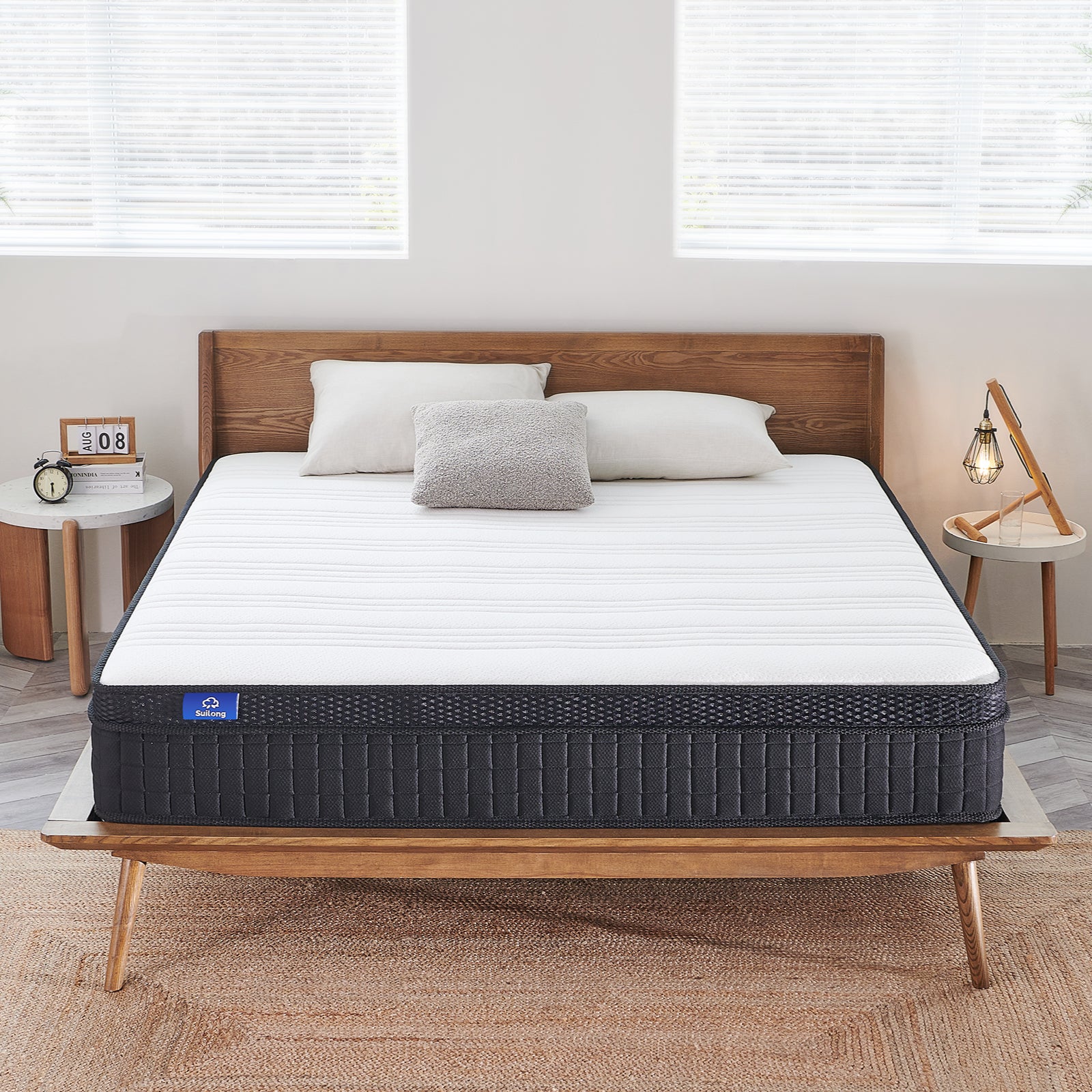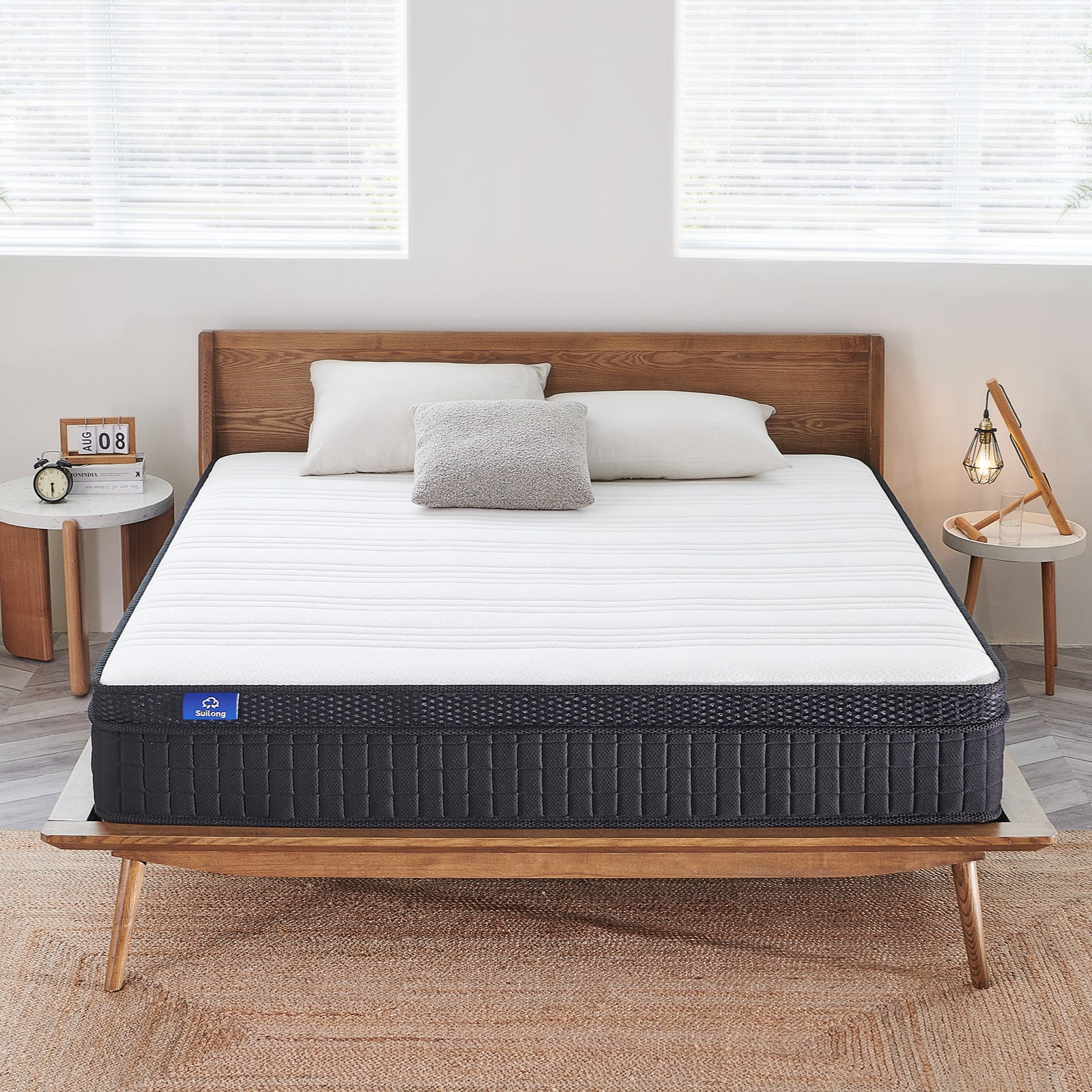How to choose a Mattress for Comfort and Support

Choosing the right mattress is crucial for a good night's sleep. Dive into the differences between memory foam, innerspring, and hybrid mattress in a box, and find the best fit for your comfort and support needs.
1. Mattress Types
Foam Mattress: Advantages and Disadvantages of memory foam mattress, Latex and other Materials
1.1 Memory Foam Mattress
In my many searches for the perfect mattress, Memory Foam has always been a material that I highly recommend. Why?
- Adaptability: Whenever I lie down on a memory foam mattress, I can feel how it adapts perfectly to my body's curves. This "tailored" feeling provides me with unparalleled comfort.
- Temperature Sensitivity: However, I also found that this mattress becomes slightly firmer in winter due to the temperature.
To solve this little problem, I chose a memory foam mattress with a "gel" component. Not only does the gel help me stay cooler in the summer, but it also doesn't get too hard in the winter, so it's really a two-for-one deal.
1.2 Latex Mattress
Latex mattresses are another favorite choice.
- It's bouncy: compared to memory foam, latex gives a slightly bouncy feel, which provides excellent support for the back and reduces back pain.
- Natural materials: Also, I really like the fact that it's mostly extracted from natural rubber trees, making it a more eco-friendly choice for my mattress.
- Innerspring mattresses: continuous spring vs. pocketed coil
1.3 Continuous Spring Mattress
When I first purchased a mattress, I opted for a continuous spring mattress due to my limited budget.
- Low cost: It was relatively inexpensive and a good choice for me on a budget.
- Average durability: But as time passed, I realized that this mattress was not as durable as I expected.
Individually pocketed spring mattress king size mattress and box spring.
I moved on to a pocket sprung mattress and have been very pleased with it.
- Excellent support: each spring is individually wrapped, which means the mattress supports my body more accurately.
- Ideal for couples or co-sleeping: another huge advantage of this design is that when I turn over during the night, my movements don't affect the other side of the bed, ensuring a deeper sleep for my partner.
- Hybrid mattresses: combining the features and benefits of foam and springs
Recently, I have become interested in hybrid mattress in a box.
It perfectly combines the benefits of memory foam and individual pocketed springs into one. Not only that, but it provides me with excellent support and comfort, making it a truly cost-effective option.
What's more, these mattresses typically have a longer lifespan than pure memory foam or pure innerspring mattresses, saving me a lot of money on replacement mattresses.
2. How to choose a mattress according to sleeping position
Side sleeper: Recommended support points and mattress firmness
- Distribute pressure on shoulders and hips
As side sleepers, our shoulders and hips are the first parts of the mattress to come into contact with the mattress when we lie down, so we need a mattress that provides enough softness to adapt to these curves and distribute the pressure at the same time.
- Maintain the natural curve of the spine
The mattress needs to provide proper support between the shoulders and hips to maintain the natural S-shaped curve of the spine and prevent back pain.
3.Mattress Recommendations
A medium firmness or slightly softer mattress is usually the best choice for side sleepers, such as the Suilong Nimbus Hybrid Mattress which provides good support and comfort for side sleepers.

Suilong Nimbus
12 Inch Hybrid Mattress
Look no further than the Suilong Nimbus 12-inch Hybrid Mattress.
Buy NowBack sleepers: Lumbar and Neck Support Highlights
1.Lumbar Support
When I lie on my back, my lower back should not sink. The mattress needs to provide proper support here to ensure there is no gap between the lumbar region and the mattress.
2.Neck Maintenance
The height of the headrest and the softness of the mattress work together to ensure that the neck is properly supported to avoid cervical problems.
3.Mattress suggestion
A medium-firmness mattress is the best choice for supine sleepers. It provides proper support for the back and lumbar region, such as Suilong's Memory Foam Mattress can meet the needs of supine sleepers.
Plank sleepers: why you need to choose a firmer mattress
- Spine prevents excessive bending
When I'm lying down, I don't want my lower back to sink excessively due to a mattress that is too soft, which can lead to excessive curvature of the spine.
- Smooth breathing
A firm mattress can ensure that your body is properly supported, preventing your face from being compressed and ensuring smooth breathing.
3. Mattress recommendations
Firm mattresses are preferred by plonkers to keep the spine in its normal position, such as Suilong's Firm Mattress range which provides plonkers with the support they need.
3. Choosing a mattress based on body type
Heavy Body Type:
As a heavy body type, when choosing a mattress, I am aware that my body has special needs for support and density.
The Importance of Height Support
When the body is heavy, the support of the mattress becomes critical. A mattress without sufficient support will allow the body to sink in, resulting in pressure on the lumbar and back areas, which can lead to discomfort in the long run.
Choose high-density materials
High-density mattress materials, such as high-density memory foam, not only provide longer-lasting support, but also ensure that the mattress will not be easily deformed after a long period of use.
Avoid too soft
Although soft mattresses give a feeling of luxury, for heavy body types like me, soft mattresses may lead to uneven pressure on the body, and long-term use may cause damage to the joints and spine.
Light Body Type:
As a light-bodied person, I pay more attention to the softness and adaptability of the mattress when choosing a mattress.
Seek a mattress that adapts to your body's curves
Choose mattresses that adapt to your body, such as medium-density memory foam mattresses that provide even support for your body while providing adequate comfort at pressure points.
Choose a medium or slightly softer mattress
For me, a medium or slightly softer mattress provides enough comfort without losing support.
Focus on the breathability of the mattress
Light-bodied people usually have higher body temperatures, so it's especially important for me to choose a mattress with good breathability to ensure all-night comfort.
Average Body Type:
As an average-sized person, I think it's important to aim for balance when choosing a mattress.
Balanced Firmness
For me, a mattress that is neither too firm nor too soft is optimal. A medium-firm mattress provides good support for my back, lumbar and neck without feeling too hard.
Focus on the choice of material
I prefer a hybrid mattress with memory foam and springs, which combines the best of both worlds with support and softness.
Weighing value against budget
As a consumer with an average need for a mattress, I focus more on value for money. Choosing a mattress that is both quality and within my budget is my primary consideration when making a purchase.
4. Price-value trade-offs
Budget versus quality: Does a higher price always mean better quality?
I wondered this when I first started buying mattresses. While it's true that price is somewhat of a reflection of the quality and materials used in a mattress, it doesn't mean that the most expensive is the best.
- Material sources and manufacturing processes: Higher priced mattresses tend to be made with better raw materials and more sophisticated manufacturing processes. For example, high-quality organic latex and high-density memory foam cost more, so they are sold at a relatively higher price.
- Branding: Certain well-known brands of mattresses may cost more than others, perhaps in part because of their investment in branding and advertising.
- Personal needs: Not everyone needs a top-of-the-line mattress. Understanding your needs and budget and choosing the right mattress based on those needs is crucial.
How to get the most value for your budget: reviews, guarantees and warranty considerations
Buying a mattress isn't just about price. To ensure you get the most value for your budget, here are some tips:
- Delve into reviews: Reading reviews from real users can help me understand how the mattress actually performs and what might be wrong with it.
- Warranty policy: a long warranty ensures that any issues that arise during use will be resolved. A reputable brand will stand behind its products.
- Test Lay Policy: Although I can't test lay online, choosing a brand that offers test lays and free returns reduces the risk of purchase.
The Importance of Investing in Health: A Long-Term Perspective and the Relationship to Sleep Health
I deeply believe that a mattress is more than just a piece of furniture; it is directly related to the quality of my sleep and my health.
- Long-term investment: Buying a high-quality mattress is an investment in long-term health. A good night's sleep can help the body recover, increase productivity, and prevent many health problems.
- Physical health: A well-supported mattress can reduce back pain and other physical discomforts.
- Mental health: Quality sleep improves mood and reduces the risk of anxiety and depression.
Buying the right mattress within your budget not only ensures that you get value for money, but also a healthy night's sleep and a better quality of life.
5. Advice on choosing a mattress for your child
Special needs during the formative years: the importance of bone development and support
- Critical stages of bone development
During the formative years of a child's life, their bones are undergoing rapid development and change. A mattress designed for the formative years will ensure that your child's spine is properly supported during sleep.
- Avoid improper posture
If the mattress is too soft, your child's spine may not be able to maintain its natural S shape, leading to long-term health problems. Conversely, a mattress that is too firm may not provide enough cushioning for the sunken parts of the body, leading to pressure points.
- Balance of Proper Support and Comfort
It's crucial to choose a mattress that adapts to the curves of your child's body while also providing adequate support. Consider a mattress with medium firmness or one with highly adaptable materials such as memory foam.
Safety considerations: environmental protection and safety of materials
- No harmful chemicals
When choosing a mattress, make sure it does not contain harmful chemicals. You can check if there is an international certification such as CertiPUR-US, which can guarantee that the mattress material is safe.
- Anti-allergy and anti-dust mite
Your child's immune system is still developing, so it is very important to choose a mattress that is anti-allergy and anti-dust mite.
- Ventilation and temperature regulation
Make sure the mattress is well ventilated so your child won't overheat in the summer and will stay warm in the winter.
Size & Longevity: Consider your child's growth and the frequency of mattress replacement
- Mattress life and quality
Usually, a high-quality mattress can last 8-10 years. Considering the growth rate of your child, this timeframe is ideal.
- Choosing the right size
Although a small size mattress may be suitable for your child's current size, considering your child's rapid growth, choosing a larger size may be more economical.
- Consider future needs
If you have enough space at home, consider purchasing a full-size or twin mattress so that your child can continue to use it as he or she grows up without having to replace it frequently.
6. How to Choose a Mattress Topper
As I began to take an interest in the care and maintenance of my mattress, I realized that a mattress topper was an essential part of the equation. A mattress topper not only extends the life of your mattress, but it also provides more comfort and protection. Next, I'd like to share with you some important facts about mattress covers.
Functions of a mattress cover
- Protects the mattress: mattress covers prevent dust, stains and bacteria from entering the mattress so that the mattress is always clean.
- Enhances comfort: certain mattress cover materials can add softness to the mattress, making your sleeping experience more comfortable.
- Extends the life of your mattress: a good mattress cover can reduce wear and tear on your mattress, making it last longer.
Choice of material
This has always been a part of the mattress cover that I've been particularly concerned about in terms of material choice.
- Materials that help regulate temperature: bamboo fibers and gel-incorporated memory foam, for example, can both provide you with a cool feeling on hot summer days.
- Waterproof materials: especially for families with children or the elderly, a waterproof mattress cover can be effective in preventing liquids from penetrating the mattress.
- Materials for added comfort: such as wool and natural latex, all of which can add extra softness to your mattress.
How to choose the right mattress cover for your mattress type
When choosing a mattress cover, I find that the type of mattress is also very important to the choice.
- For foam mattresses: I recommend a mattress cover that breathes well, as foam mattresses can be relatively breathable on their own.
- For innerspring mattresses: innerspring mattresses are more breathable, so a wool or latex mattress cover that adds softness would be a better choice.
- For hybrid mattresses: depending on your personal needs, such as whether you need extra coolness or softness, choose a mattress cover with corresponding features.
When choosing a mattress cover, my advice is to always consider your actual needs and the type of mattress you have so that you can provide yourself with the most comfortable sleeping experience.
Having the right mattress can transform your sleep quality. By understanding various types and their benefits, you can invest wisely in your sleep health. Sweet dreams!
FAQs
Q: What type of mattress is most supportive?
A: Hybrid mattresses often provide the highest level of support by combining the contouring properties of memory foam with the resilience of innerspring coils.
Q: Is a soft or firm mattress better for seniors?
A: It depends on individual preferences and health issues. Many seniors benefit from a medium-firm mattress, which provides adequate support while alleviating pressure points, especially for those with joint pain or arthritis.
Q: How do I choose a mattress without trying it out?
A: Look for comprehensive online reviews, consider your sleeping position and personal needs, and opt for brands that offer a risk-free trial period, allowing you to test the mattress at home.
Q: What factors determine the durability and comfort of a mattress?
A: Factors include the quality of materials used, the construction method, and the thickness of the mattress. Brands that undergo third-party certifications (like ISO9001 or SGS) tend to offer more durable products.
Q: What should I avoid when buying a mattress?
A: Avoid making a decision solely based on price. Also, neglecting to read the return policy and warranty terms, or overlooking customer reviews and feedback, can lead to regrets later.
-
Posted in
best sleeping position, box spring for hybrid mattress, Buyer's Guide, Choosing the Right Mattress, hybrid mattress, hybrid mattress vs memory foam mattress, Is Memory Foam Good for Side Sleepers, Lifestyle, Mattress Buying Guide, Mattress thickness, Mattress Tips, Mattress Topper, Shopping Tips, sleep health, sleep position, Sleep Tips, sleeping positions, soft Mattress, the type of mattress



















